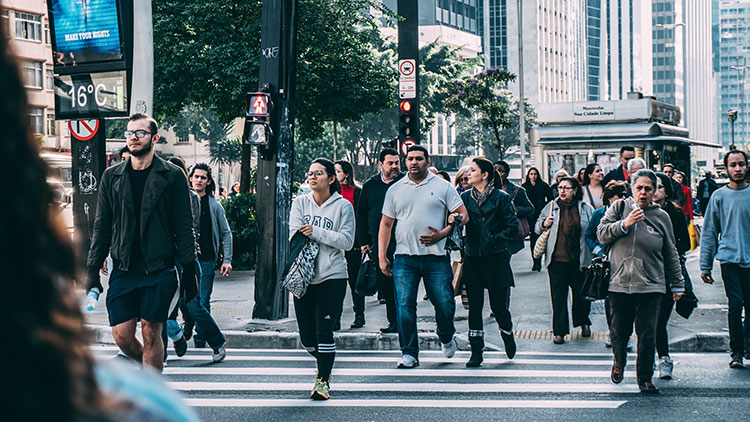As the U.S. Department of Transportation establishes October as the first-ever National Pedestrian Safety Month, Caltrans is refining its programs to reduce injury and death on California roadways.
 Pedestrian deaths have increased nationwide over the last decade. In California, pedestrians are 37 times more likely to be injured in a collision than any other roadway user. Between 2008 and 2017, pedestrian-related incidents accounted for 19 percent of all collisions resulting in death or serious injury.
Pedestrian deaths have increased nationwide over the last decade. In California, pedestrians are 37 times more likely to be injured in a collision than any other roadway user. Between 2008 and 2017, pedestrian-related incidents accounted for 19 percent of all collisions resulting in death or serious injury.
“At least two pedestrians or cyclists lose their lives on California’s transportation system each day — a number we refuse to accept or normalize,” said Caltrans Director Toks Omishakin. “Safety remains our top priority and the department will work diligently until the trend is reversed. Data-driven augmentations to safety features and a recent $100 million investment dedicated to pedestrian-focused infrastructure improvements will help enhance safety for those who walk and bike on California roadways.”
 The most recent study, covering 2007 to 2013, found pedestrian injuries have declined nine percent but Santa Cruz County, despite its small size, had the 7th highest rate of non-fatal pedestrian injuries, comparable to San Mateo and San Diego counties.
The most recent study, covering 2007 to 2013, found pedestrian injuries have declined nine percent but Santa Cruz County, despite its small size, had the 7th highest rate of non-fatal pedestrian injuries, comparable to San Mateo and San Diego counties.
Caltrans is analyzing high-risk locations using traffic collision data, then using a first-of-its-kind toolbox — with 47 safety measure — to determine the best safety improvement. Improvements include:
- Signal timing adjustment and extended pedestrian crossing times.
- Intersection and roadway design changes, such as sidewalks, curb extensions, and roundabouts or raised intersections that provide more pedestrian safety in high traffic locations.
- New signs and markings, including high-visibility crosswalks, stop and yield markings, or “yield to pedestrian” signs.
Caltrans is already implementing these safety measures in certain locations — so far, none in Santa Cruz County — and expects to identify further locations by September 2021.
In addition, the California Transportation Commission recently approved $100 million for projects that promote active transportation options, such as:
- 310 miles of new and repaired bike lanes
- Installation and repair of nearly 50 miles of sidewalk
- Nearly 3,000 new crosswalks
- 178 transit stop improvements, such as bus shelters
The California Office of Traffic Safety is providing more than $8 million in funding for programs dedicated to the safe and equal access of roads for pedestrians, including:
- Complete Streets Safety Assessments to assist local agencies statewide in identifying and implementing infrastructure improvements to pedestrian safety and accessibility.
- Community Pedestrian and Bicycle Safety Training programs that encourage local residents in underserved communities to develop a community action plan to improve walking and biking safety.
- Coordinate Walking Tours and education outreach with health care providers and senior centers. Focus on high-collision areas for older adult pedestrians and measures to improve safe travel for older adults.
- Develop “walking school busses” with groups that walk with students to school and educate students on traffic rules and best safety practices.
National Pedestrian Safety Month is an important reminder that we are all pedestrians at one time or another and that we all play a role in protecting those who walk on California’s transportation system.
“Behavior change goes hand in hand with infrastructure improvements,” said Barbara Rooney, director of the Office of Traffic Safety. “Safe habits by drivers and pedestrians complement a transportation system that is designed with pedestrian travel in mind.”
Tips for drivers:
- Slow down on busy streets and intersections.
- Avoid distractions like cell phones, eating, using in-dash touch screens, or deep conversations with passengers.
- Be extra careful when approaching crosswalks.
- Be prepared to stop for pedestrians.
- Avoid blocking crosswalks when making a right-hand turn.
- Turn headlights on and slow down at night when pedestrians are more difficult to see.
Tips for pedestrians:
- Stay off the phone, especially when crossing the street.
- Always try to use marked crosswalks, preferably at stop signs or signals.
- Make eye contact and nod or wave at drivers. A quick nod or wave is an easy way to let a driver know you see them, and they see you.
- Be careful crossing streets or entering crosswalks at night when you’re more difficult to see.
- Walk with a flashlight and wear a reflective vest at night to make it easier for drivers to see you.
- Remember to look both ways for cars if you need to briefly walk into the street to maintain social distancing on sidewalks.
•••
For information about Caltrans pedestrian programs see dot.ca.gov/programs/safety-programs/ped-bike and visit the Office of Traffic Safety gosafelyca.org/bicycle-pedestrian-safety/ website for pedestrian safety tips.
